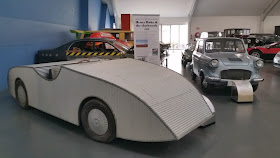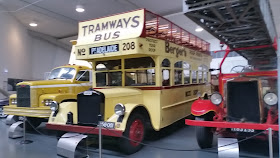
Carrick Hill is only 20 minutes from central Adelaide. It has fine gardens and artworks on display. There was a wedding on that evening on the front lawn. www.carrickhill.sa.gov.au

The lawns are fine location for a small car show

All up more than a dozen vehicles showed up

Attending from SIVA were Rhys Mitchell and his son Alex in a Chevrolet Corvair Monza (above), Paul and Natalie Blank and family in a Rolls-Royce Silver Shadow, Stef and Yvonne Brayley in their Alpine A110 and Peter Schelfhout in his Peugeot 404 (below).

Peter had driven over from Perth and only arrived that afternoon. The drive had proven quite challenging as the car had experienced some problems with tuning and seizing brakes.

A trio of Renault 8's

The Renault Caravelle on the left received a lot of attention. It is a very fine looking car with a body by Ghia, but underneath the sporty exterior is Renault 8 running gear.
The Bay to Birdwood starts at Barrett Reserve in the beachside suburb of Glenelg. Cars begin gathering at 6am and are parked up for the breakfast and display. We set off from Adelaide CBD around 7am but were delayed by carburetor issues. The car ran really rough in second and third before smoothing out in fourth, but in the suburban streets around the city we rarely got up to fourth. We arrived around 8am and parked up next to a couple of VW Kombis.

We hardly stepped out of the car before being swamped by people wanting to talk about the car. I like talking to people about the DKW but I was trying to give the carb a quick clean at the same time and it was a little frustrating.

As the SIVA crew were staying all over Adelaide and had set off at different times, we were scattered across the field. 1750 cars all in one place!! The sheer logistical effort involved in coordinating that many vehicles is amazing. By sheer luck we bumped into Rhys and Alex and Paul Blank and said our good mornings, then we were lost in the crowd.

A perennial crowd pleaser is the Delorean. There were four attending.

A great rarity in Australia - Saab 96 longnose. This was a V4 powered model.

A very fine Porsche 356

I think this Holden 48-215 (aka FX) was outside the age cut off, being built from 1948 to 1952, but might have been exempted due to the shut down of the Holden plant this year.

There was a lot of American iron around - as you must expect these days. This was fine Cadillac Eldorado. I had always wanted one of these as a kid but my admit my tastes have changed a lot since then.

A lovely restored Volkswagen Karmann Ghia with correct paint scheme. Shelly chose to paint the roof of her Karmann Ghia white, which does look lovely of course, but the cherry red body originally came with a black roof.

A duo of French Sima Aronde's. A real pair of rarities. Simcas were manufactured in South Australia in the 1960s.

I think this Simca Aronde was one of the most interesting cars at the event.

This Buick had come over from Victoria.

This EH Holden is the spitting image of the one I owned in the 1990s.

A Saab Sonett in our rear view mirror.

At 9am the first cars were waved on their way. It was almost an hour before it was our turn to go. The car was still running rough but we were too preoccupied to care. The streets surrounding the reserve were filled with spectators lining the road. It was a cold morning with the threat of morning rain but they still came anyway, seated in folding chairs and wrapped up in coats and blankets. There were a lot spectators lining Anzac Highway all waving and pointing. It was excellent.

Driving towards the start.

Crowds on the median strip on ANZAC Highway.

The Saab Sonett overtakes us.
This year the route took us back through the centre of Adelaide. For the last couple of years the route has gone around the centre due to the traffic congestion it caused. Personally I think this was a mistake as there was a lot of traffic on the road (despite it being early on a Sunday morning in Adelaide!) and progress ground to a crawl. The slower we went the worse our car performed and we stuttered along, but at least we did not stall or overheat. Plenty of other cars did though. Among the 1750 cars big Australian and American cars predominated other vehicles and the slow going was tough on their big engines. The roadside was littered with overheated cars with their bonnets up. I think if the organizers want to do the city route next year they should restrict access on some of the roads so that the parade can be quickly waved through.

A fairly common sight during the crawl through the city. There were actually two Cadillacs parked on the roadside together.

We drove on north east towards the Adelaide Hills. Away from the city centre there were more spectators and lots of non-participating enthusiasts had bought their cars out of their garages and parked on their lawn in solidarity. I remember one house had a collection of classic Alfa-Romeos parked out the front while they waved and tooted their horns. The car continued to be troublesome though and I pulled over into a petrol station to clean the carb again and get a drink. Many other cars pulled over too for fuel, food, drink and use the toilet. The place was packed so we didn't get away for about 20 minutes. We still had problems but the car was running a little better.

The convoy had also spread out by now so we weren't jammed together. We could get up into fourth gear and get a bit of run. We were soon up in the Hills and the route to Birdwood was actually closed to general traffic. That meant we could tootle up the hills as slow as we needed to while the traffic went around us. I was surprised to note as we ground our way up in second gear (30 miles an hour) that a Ford Falcon GT was following us and made no attempt to overtake. Quite extraordinary!

The route through the Hills was scenic, twisty and not too steep. We certainly weren't the fastest car on the road but we were far from the slowest. However, as we were passing a small lake (I don't know where it was exactly) on a general rise, the car experienced fuel starvation. This sometimes happens on a long rise where you can't afford to vary the throttle for fear of the revs dropping down to first gear speed (the car has a non-synchro first gear). We really needed to stop, feather the throttle a little to get the fuel flowing smoothly again and then set off. I spotted an area of gravel just large enough to pull the car over and we instantly stalled. After a bit of cranking she fired up with a little bang. Whatever had been blocking the carb was gone and she ran beautifully for the rest of the day.

1750 cars set out from bayside Adelaide but not everyone stops in Birdwood. Some participants arrive, collect their certificates and then turn for home. We were so far back in the pack that there loads of cars passing us on their way back. It was still grindingly slow getting into Birdwood. At least a thousand cars were parked in the museum grounds. As an interstate club the SIVA members were supposed to parked together somewhere near the museum entrance, but we were now spread all over the place. One member was in the concourse. Another had obtained a VIP pass and the others were parked randomly. One sharp eyed marshal spotted our club logo and explained to us where we were meant to park, but in the crowd of cars we were redirected into the general entry. We saw the SIVA flag flying across the field so we tried to make our way to them, but it was hopeless. We decided to park wherever we could find a spot.

Cars in the field

More cars...
As we drove through the crowd we bumped into Peter, Stef and Yvonne and Peter warned us that our exhaust was "swinging in the wind." That wasn't good news! A quick inspection revealed that the new rubber mounting bracket holding the exhaust on had snapped. This was a read problem as the exhaust was now held on only by the mounting beneath the front seat. It would not have been a good idea to drive back to Adelaide without a fix. We removed the broken mount and took it to the RAA (Royal Automobile Association) guys who strapped it up temporarily with cable ties. It wasn't a pretty fix but it would get us home.

This mounting block was not original but exhaust shop couldn't find anything else that would fit. I believe the block came from a Landrover. Anyway, one of the metal plates tore away from the rubber mount.

With the added thickness of the cable ties the repaired mount was a bugger to reinsert. Thanks to Paul Blank who help me put it back on. Here Paul is using his feet to push the exhaust away from the mounting bracket so I can force the block back into position. Definitely a two person job.
All this fuss kept us from really appreciating our time at Bay to Birdwood and we did not get to enjoy the display at the National Motor Museum. We also missed catching up with the other SIVA members and people from the Historic German Register of Australia who'd come to the show to catch up with us. I felt the end of the event was rather chaotic with people leaving the display area.

The Shannon's Goggomobil

50 years of Volvo display

Mowag truck from Switzerland

Paul's Rolls Royce flying the SIVA flag

How did this guy get in here? An Austin 7 that is definitely outside the date range.

Lovely Mazda Cosmo

Steyr-Puch Haflinger. There were two in attendance.

Stef and Yvonne Brayley and their Alpine A110 in the concourse. Stef drove the car all the way back to Perth!

BMW 2002

Fashions in the Field. Stef and Yvonne were ripped off. Stef's suit is not fancy dress. He's owned it since the 1960s!


Bay to Birdwood was a great experience and we enjoyed it immensely, despite the less than perfect performance of the car on the day. Ironically the car drove magnificently the next day when we drove to the drop-off. However, the Classic event was a little disappointing for me as the event was dominated by the 'usual suspects' - 369 Holdens and 277 Fords. But that is Australia isn't it. The entry lists are here: http://baytobirdwood.com.au/btb-2016/the-2017-vehicles The efforts of the organizers are to be congratulated. Bay to Birdwood is a major logistical undertaking and the support they have obtained from the community is fantastic.

Daisy heads home back to Perth with Ryans Transport.

I've since fixed the exhaust mounting. Again, it's not an original fitting - the exhaust is a little out of original alignment. This silent block is a little smaller than the Landrover mount. I hope it lasts, but suspect I'll need to add another bracket to the back end of the mount to reduce lateral tension.
Back to the travels with a DKW part one http://heinkelscooter.blogspot.com.au/2017/10/travels-with-dkw.html
And part two http://heinkelscooter.blogspot.com.au/2017/11/more-travels-with-dkw.html





























































